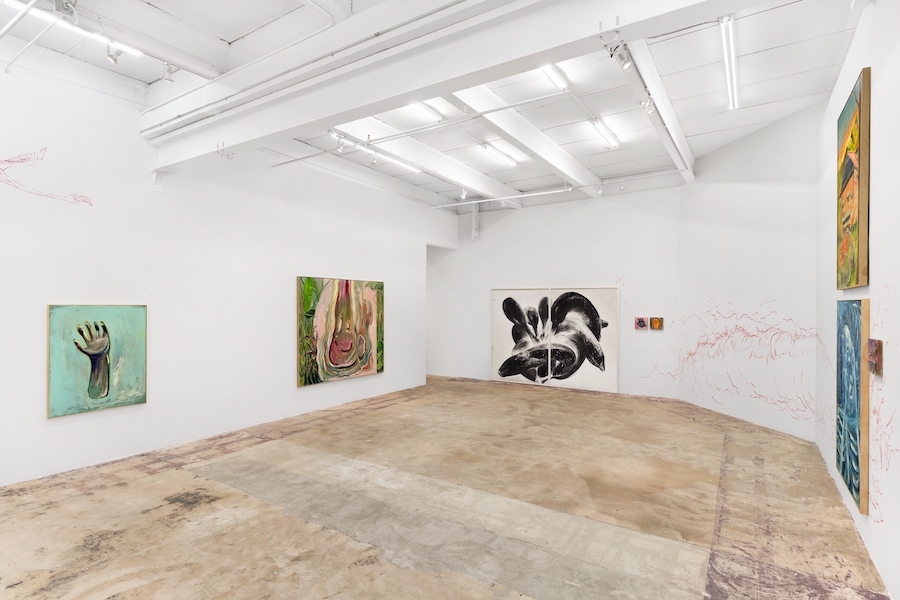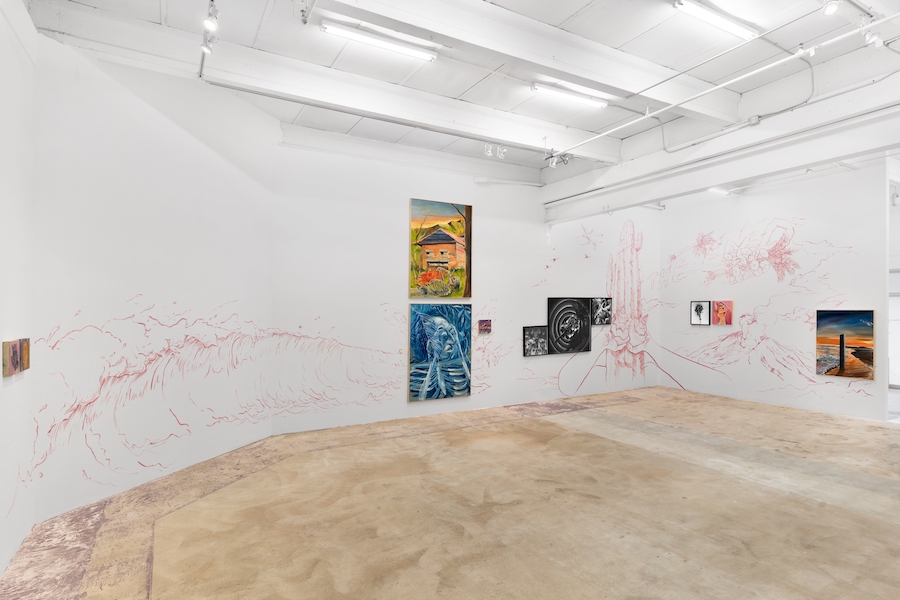GONZALO FUENMAYOR + MARCOS CASTRO
TREMORS IN PARADISE
Text by Carlos Huffmann
November 18, 2022 — January 20, 2023
Gallery I







Marcos Castro, Gonzalo Fuenmayor, and I belong to the same generation. For that reason, we share the cultural baseline of our imagination which we can imagine being a geological ground from which the flora and fauna of our work as artists can emerge. We were born to witness the birth and emergence of the digital world, and as impressionable minds, we lived and breathed a political and intellectual project called “postmodernism”, characterized by postulates like Richard Rorty’s amazing maxim: “Truth is a property of sentences, since sentences are dependent for their existence upon vocabularies, and since vocabularies are made by human beings, so are truths.”
As a generation, we also lived in the age of proud scientism where general relativity, explained to us that time passes differently for different observers. Quantum indeterminacy teased our fantasy by suggesting that undead cats were scientifically possible and, as Einstein famously complained, god seemed to be playing dice to determine what is actually the case in the cosmos.
In more recent years, humanity has been taught that there are “facts”, and that there are also “alternative facts”. The popularization of the term “Post-truth” has both made us critical of an oftentimes corrupt media as well as it has empowered strange cults that believe that the planet is a flat disc somehow floating in space, or that quantum effects might be harnessed to improve your sex life. Our current models for cosmology suggest that space might be infinite and homogeneously dense, which means that all possible realities are the case somewhere, which would have frankly mind-melting implications that I will not try to explain here(I recommend to you, dear reader, to go to youtube.com and look up “what would an infinite cosmos mean?”).
To make matters even more unsettling, the Nobel prize for physics was awarded just one month ago for the discovery that quantum physics’ most bizarre implications actually check out in an experimental setting. It is said that this is the first time ever that a Nobel prize is given out to a discovery that renders the world stranger instead of making it more comprehensible and knowable.
All of these developments coalesce into a kind of epistemological singularity, a “post-reality” moment that our collective imagination is being pulled irresistibly towards. Like never before, humanity will be without narratives, scientific or theological grounds on which to stand and make sense of the world. Like never before, it will be clear how important the production of meaning, I mean art, is as a provider of symbolic sustenance for the human experience.
Marcos Castro and Gonzalo Fuenmayor are artists that work in hybrid languages, mixing what to others might seem like heterogeneous regimes of signs into complex pictures that realize meaningful images of the entangled world that we exist in. The works featured in this show all feature iconic categories superimposed with their antinomian, the serious and the silly, hopelessness and optimism, fields of color and linework, precariousness, and opulence. The vantage point of this exhibition is of two artists that viscerally understand the mediums they utilize as vehicles to reorganize the collective mind and make it more proficient at seeing the fragmented and compartmentalized reality for what it is: a beautiful landscape of knowns and unknowns that is nestled in an awesome and sometimes terrifying infinity of abstraction.
Carlos HuffmannArtist and Director of the Art Department Torcuato Di Tella University
Click here to watch Gonzalo Fuenmayor + Marcos Castro Video
Click here to see the artworks of the show
ANASTASIA SAMOYLOVA
FLORIDAS
Text by David Campany
November 18, 2022 — January 20, 2023
Gallery II







Comprising a selection of works from her photographic project: Floridas, the exhibition showcases a new body of work which depicts the state of Florida as a nuanced portrait of the contemporary United States and tests for endurance the narratives of the iconic American Dream.
Sunshine State. Swampland paradise. Tourist aspiration. Political swing-state. Real estate racket. Refuge of excess. Sub-tropical fever dream. With forms of nature and culture found nowhere else, Florida is unique. It is also among the most elusive and misunderstood of places.
Florida has a reputation across the United States and internationally as an extremist place of extravagance, indulgence, hedonistic tourism, and sunny retirement, but the reality is very different. Its politics and culture are as mixed as its demographics, in this, it has become a microcosm of the divisions and differences of the USA as a whole. “I believe that what is happening in the extremes of Florida is happening across the country,” recounts the artist.
Anastasia Samoylova traverses Florida on intensive, wandering road trips from the Keys to the borders with Alabama and Georgia. She creates acutely observed photographs that distill our contradictions and confusions, looking for unexpected resonances in familiar motifs. The images are visually striking but complex, with subtle references both to Florida’s conflicted history and to the way it has been imaged so intensively by others. Her wide-ranging project Floridas takes its inspiration from Walker Evans, the American photographer who documented the state between the 1930s and the 1970s. Like Evans, Samoylova moves between color and black and white, looking closely at the telling details in landscapes, cityscapes, people, objects, and interiors that speak volumes about the culture and social values.
For Samoylova, photography is a uniquely placed to communicate with a braod audience, opening up questions in accessible ways beyond the usual audiences for art. Her images have multiple entry points to their layered meanings, making them accessible to viewers from diverse backgrounds with different perspectives and expectations.
A book published by Steidl and edited by David Campany, including the images of Floridas and a selection of Walker Evans’ photographs, was recently released.
Anastasia Samoylova (b. 1984) is a Russian-American artist who moves between observational photography and studio practice. Her work explores notions of environmentalism, consumerism and the picturesque. She investigates and evidence the complex relationship between the nature and human society. Samoylova’s photography plays around the collective memories and the narratives of geography. Samoylova received her MFA from Bradley University and MA in Environmental Design from the Russian State University for the Humanities. In 2021 Samoylova won the first edition of the KBr Photo Award. Recent exhibitions include Eastman Museum; Chrysler Museum of Art; The Photographer's Gallery; Kunst Haus Wien; History Miami Museum; and Museum of Fine Arts, Le Locle.
In 2022 Samoylova was shortlisted for the Deutsche Börse Photography Foundation Prize. Her work is included in the permanent collections at the Perez Art Museum Miami and Museum of Contemporary Photography Chicago, among others. Published monographs include Floridas (Steidl, 2022) and FloodZone (Steidl, 2019)
Click here to watch Anastasia Samoylova Video
Click here to see the artworks of the show


